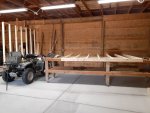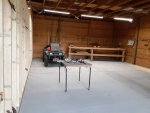- Joined
- May 15, 2020
- Messages
- 3,959
- Age
- 70
- City
- Atlanta
- State - Country
- GA - USA
- Other
- Manufacturers factory tour, maybe big dealership tour
- Vehicle Year
- 1997 1987
- Engine
- 4.0 V6
- Transmission
- Manual
- Total Lift
- 97 stock, 3” on 87
- Total Drop
- N/A
- Tire Size
- 235/75-15
- My credo
- Never put off ‘til tomorrow what you can put off indefinitely
Looks great!!
For the cuts to work right/crack, basically two factors: first, was the prep work done so the dirt/underpayment was very level? If so, a cut of just a small depth will create the weak spot for the crack. Second, the cut has to be deep enough to overcome irregularities. For example, if the substrate wasn’t very level, the crack will appear along the side of the deepest parts of the pour, the weak spot. The solution is the same, just cut deeper. & the third of the two factors: cut it ASAP, while the concrete is still “green” and curing. The cracks don’t appear suddenly like breaking a window. As the concrete cures they slowly develop. The sooner you cut it, the better you can control the cracking.
Sealing, that’s a must, and use a true concrete sealer. It actually completes the curing chemical reaction and enhances the cure, yielding a really hard surface. Should be done 28 days out (90% cure). If you do it too soon, the surface will be harder than the depth, and it could actually fracture on the plane, delaminates, resulting in thin layers that will fail. BTW, don’t drill & place any anchor bolts for the same 28 days.
As far as filling the cracks, that is predominantly to keep water out so it will not freeze and bust up the slab. If it never gets wet inside, and it never goes below freezing (not even one time) you really don’t have to caulk it. Having said that, it’s still advisable, just not mandatory.
& one last thing I’ve learned over the years:
It’s great to keep a little pussy around, but if you don’t keep a close eye on it, it’ll get you in trouble every time!
For the cuts to work right/crack, basically two factors: first, was the prep work done so the dirt/underpayment was very level? If so, a cut of just a small depth will create the weak spot for the crack. Second, the cut has to be deep enough to overcome irregularities. For example, if the substrate wasn’t very level, the crack will appear along the side of the deepest parts of the pour, the weak spot. The solution is the same, just cut deeper. & the third of the two factors: cut it ASAP, while the concrete is still “green” and curing. The cracks don’t appear suddenly like breaking a window. As the concrete cures they slowly develop. The sooner you cut it, the better you can control the cracking.
Sealing, that’s a must, and use a true concrete sealer. It actually completes the curing chemical reaction and enhances the cure, yielding a really hard surface. Should be done 28 days out (90% cure). If you do it too soon, the surface will be harder than the depth, and it could actually fracture on the plane, delaminates, resulting in thin layers that will fail. BTW, don’t drill & place any anchor bolts for the same 28 days.
As far as filling the cracks, that is predominantly to keep water out so it will not freeze and bust up the slab. If it never gets wet inside, and it never goes below freezing (not even one time) you really don’t have to caulk it. Having said that, it’s still advisable, just not mandatory.
& one last thing I’ve learned over the years:
F'n cat
It’s great to keep a little pussy around, but if you don’t keep a close eye on it, it’ll get you in trouble every time!















